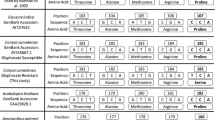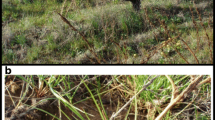Abstract
Resistance to ALS-inhibiting herbicides in Lactuca serriola first appeared in the northern Yorke Peninsula in South Australia in 1994, with resistance soon observed at a number of additional sites. The rapid appearance of resistance at many sites could be attributed to a number of independent selection events or to movement of resistant seed from the original field. ISSRs were used to genotype plants collected in 1999 and 2004 from roadsides or fields in an attempt to determine the importance of these two factors in the spread of herbicide resistance in L. serriola. In 1999 and 2004, chlorsulfuron-resistant L. serriola plants were found in both fields and roadsides with resistant plants being more frequent in fields than roadsides and more frequent in 2004 than in 1999. Genetic relationships generated using UPGMA analysis indicated the presence of more than one genotype within the herbicide resistant populations sampled for both years and suggested independent selection as well as movement of resistant seed had occurred. DNA extracted from samples collected in 1999 was used to sequence a highly conserved region of the ALS gene that coded for a single amino acid modification within the gene. Four different mutations were identified within the resistant samples and these mutations tended to cluster on a geographical basis. Together these data provide evidence for both multiple independent evolutionary events and for the potential movement of individual genotypes as far as 43 km in the region.




Similar content being viewed by others
References
Alcocer-Ruthling M, Thill DC, Mallory-Smith CA (1992) Seed biology of sulfonylurea-resistant and -susceptible biotypes of prickly lettuce (Lactuca serriola). Weed Technol 6:858–864
Amor RL (1986) Incidence and growth of prickly lettuce (Lacutca serriola L.) in dryland crops in the Victorian Wimmera. Plant Prot Quart 1:148–151
Andrews TS, Morrison IN, Penner GA (1998) Monitoring the spread of ACCase inhibitor resistance among wild oat (Avena fatua) patches using AFLP analysis. Weed Sci 46:196–199
Boutsalis P (1996) Resistance to acetolactate synthase-inhibiting herbicides in Sonchus oleraceus, Sisymbrium orientale and Brassica tournefortii. Ph.D. Thesis, University of Adelaide, School of Science, Department of Crop Protection
Cavan G, Biss P, Moss SR (1998) Localized origins of herbicide resistance in Alopecurus myosuroides. Weed Res 38:239–245
Dauer J, Mortensen DA, Vangessel MJ (2007) Temporal and spatial dynamics of long-distance Conyza canadensis seed dispersal. J Appl Ecol 44:105–114
Doyle JJ, Doyle JL (1987) A rapid DNA isolation procedure for small quantities of fresh leaf tissue. Phyto Bull 19:11–15
Eberlein CV, Guttieri MJ, Mallory-Smith CA, Thill DC, Baerg RJ (1997) Altered acetolactate synthase activity in ALS-inhibitor resistant prickly lettuce (Lactuca serriola). Weed Sci 45:212–217
Feráková V (1977) The genus Lactuca L. in Europe. Komenský University Press, Bratislava (Czechoslovakia). 122 pp
Gressel J (1982) Interrelating factors controlling the rate of appearance of resistance: the outlook for the future? In: LeBaron HM, Gressel J (eds) Herbicide resistance in plants. Wiley, New York, pp 325–347
Gupta M, Chyi YS, Romero-Severson J, Owen JL (1994) Amplification of DNA markers from evolutionarily diverse genomes using single primers of simple-sequence repeats. Theor Appl Genet 89:998–1006
Guttieri MJ, Eberlein CV, Mallory-Smith CA, Thill DC, Hoffman DL (1992) DNA sequence variation in domain A of the acetolactate synthase genes of herbicide-resistant and -susceptible weed biotypes. Weed Sci 40:670–676
Heap IM (1997) The occurrence of herbicide-resistance weeds worldwide. Pestic Sci 51:235–243
Heap IM (2005) Distribution of ALS resistant species. http://www.weedscience.org/ALSdistn.GIF. Cited 15/09/2005
Hood GM (2004) PopTools version 2.6.2. Available on the Internet. URL http://www.cse.csiro.au/poptools. Cited 11/03/2007
Mallory-Smith CA, Thill DC, Dial MJ (1990) Identification of sulfonylurea herbicide resistant prickly lettuce (Lactuca serriola). Weed Technol 4:163–168
Marks M, Prince S (1981) Influence of germination date on survival and fecundity in wild lettuce (Lactuca serriola). Oikos 36:326–330
Marks M, Prince S (1982) Seed physiology and seasonal emergence of wild lettuce (Lactuca serriola). Oikos 38:242–249
Maxwell BD, Mortimer AM (1994) Selection for herbicide resistance. In: Powles S, Holtum JAM (eds) Herbicide resistance in plants: biology and biochemistry. Lewis, Boca Raton, pp 1–26
Mejias JA (1994) Self-fertility and associated flower head traits in the Iberian taxa of Lactuca and related genera (Asteraceae: Lactuceae). Plant Syst Evol 191:147–160
Meyer W, Mitchell TG, Freedman EZ, Vilgays R (1993) Hybridization probes for conventional DNA fingerprinting used as single primers in the polymerase chain reaction to distinguish strains of Cryptococcus neoformans. J Clin Microbiol 31:2274–2280
Nei M (1972) Genetic distance between populations. Am Nat 106:283–292
Nei M (1978) Estimation of average heterozygosity and genetic distance from a small number of individuals. Genetics 89:583–590
Preston C, Stone LM, Rieger MA, Baker J (2006) Multiple effects of a naturally occurring proline to threonine substitution within acetolactate synthase in two herbicide-resistant populations of Lactuca serriola. Pestic Biochem Physiol 84:227–235
Reddy MP, Sarla N, Siddiq EA (2002) Inter simple sequence repeat (ISSR) polymorphism and its application in plant breeding. Euphytica 128:9–17
Schoennagel TL, Waller DM (1999) Understory responses to fire and artificial seeding in an eastern Cascades Abies grandis forest, USA. Can J For Res 29:1393–1401
Souframanien J, Gopalakrishna T (2004) A comparative analysis of genetic diversity in blackgram genotypes using RAPD and ISSR markers. Theor Appl Genet 109:1687–1693
Tranel PJ, Wright TR (2002) Resistance of weeds to ALS-inhibiting herbicides: what have we learned? Weed Sci 50:700–712
Watrud LS, Lee EH, Fairbrother A, Burdick C, Reichman JR, Bollman M, Storm M, King G, Van de Water PK (2004) Evidence for landscape-level, pollen-mediated gene flow from genetically modified creeping bentgrass with CP4 EPSPS as a marker. Proc Natl Acad Sci USA 101:14533–14538
Weaver SE, Downs MP (2003) The biology of Canadian weeds 122. Lactuca serriola L. Can J Plant Sci 85:619–628
Wu K, Jones R, Dannaeberger L, Scolnik PA (1994) Detection of microsatellite polymorphisms without cloning. Nucleic Acids Res 22:3257–3258
Zietkiewicz E, Rafalski A, Labuda D (1994) Genome fingerprinting by simple sequence repeat (SSR)-anchored polymerase chain reaction amplification. Genomics 20:176–183
Acknowledgments
Dr Mary Rieger, Dr Peter Crisp, Sally Garvie, and Bradley Mack who conducted the 1999 survey, assessed chlorsulfuron resistance in these plants and provided the 1999 DNA samples.
Author information
Authors and Affiliations
Corresponding author
Additional information
Communicated by H. H. Geiger.
Rights and permissions
About this article
Cite this article
Lu, YQ., Baker, J. & Preston, C. The spread of resistance to acetolactate synthase inhibiting herbicides in a wind borne, self-pollinated weed species, Lactuca serriola L.. Theor Appl Genet 115, 443–450 (2007). https://doi.org/10.1007/s00122-007-0576-3
Received:
Accepted:
Published:
Issue Date:
DOI: https://doi.org/10.1007/s00122-007-0576-3




